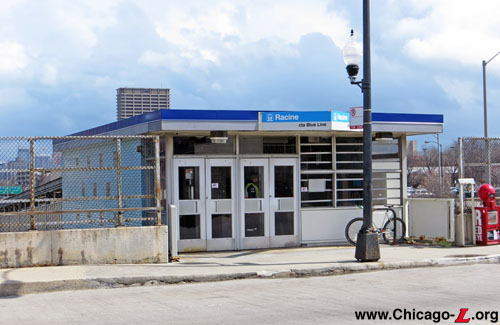
The Loomis station house at the Racine Blue Line station is seen looking east on March 31, 2016. Most of the structure remains as originally built, although its front doors have been changed and other small modifications made. As of October 2023, the Loomis Street station house was the only access point to the Racine station, following the Racine Avenue station house's closure and demolition for reconstruction. For a larger view, click here. (Photo by Graham Garfield) |
|
Racine
|
(1200W/430S)
Racine
|
|
(1400W/430S)
Loomis
|
Between Racine Avenue and Loomis
Street, and the Eisenhower Expressway, Near West Side
Service
Notes:

|
Blue Line:
Forest Park |

|
Accessible
Station |

|
Owl
Service |
Quick Facts:
|
Address:
|
430 S. Racine Avenue
(Racine
entrance)
|
|
431 S. Loomis Street
(Loomis
entrance)
|
Established: June 22, 1958
Original Line: West-Northwest Route, Congress branch
Previous Names: none
|
Skip-Stop Type:
|

|
Station
|
Rebuilt: 2023-2026
Status: In Use
History:
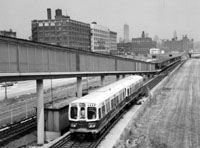
The Racine
platform, as seen looking east from the Loomis Street overpass on June 9, 1968 as a 2-car train of 2000-series cars enters the station.
The ramp in the foreground goes to Loomis; the one in the
far background leads up to Racine Avenue. For a larger view,
click here. (Photo from the Scott Greig Collection) |
The original Racine station of the Metropolitan West Side "L" was built as part of the
Met's main line in 1895. This station and the rest of the
main line and Garfield Park branch were demolished in 1953
while the Congress Street (now Eisenhower) Expressway was being constructed; the former station was location on what is now just north of the westbound lane of the
expressway, at the top of the slopping berm down to the depressed highway. The Metropolitan's main shop at Centre Street and their Loomis Street Power House were also
where the current Racine station is. The plan for the Congress Expressway included a novel concept: a rapid transit line in
the median of an expressway, making a sort of transit
corridor. The "new" Congress Line thus provided no net gain
for the "L" system.
The Racine Congress Line station was nearly identical to every other station built in the Eisenhower Expressway, including an island platform, a small station house on Racine's and Loomis's overpasses containing only a ticket booth and turnstiles and a long, enclosed, sloping passageway/ramp connecting the two. The Congress Line stations were largely devoid of the type of ornamentation seen in the previous 50 years of station design, save perhaps for the illuminated signs and cast door handles on the station buildings, and provided only the most minimal, necessary amenities.
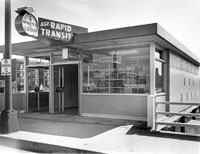
Racine station's
Loomis entrance is seen in 1958, around the time of its opening. The station house's design was typical of those built for the Congress Line, including the glazed brick sides and glass and aluminum storefront, and the unique bright red, neon-lit sign over the entrance and cast metal CTA logo door handles. For a larger view,
click here. (CTA photo) |
The entrance buildings were small compared to many older stations, about 42 feet long and 21 feet wide, erected on a concrete platform level with the overpass over the expressway, supported by concrete columns rising from the trackbed below. The walls of the buildings were made of glazed brick on the exterior face and glazed tile on the interior. Three pastel-shade colors for the brick and tile -- canary yellow, light blue and light gray -- were alternated for the Congress stations to avoid monotony and to more easily differentiate the various stops; Racine used light blue. These color schemes were followed throughout the interior of station buildings for the masonry and on all painted surfaces, except ceilings. Glass blocks, 8" x 8" each in square groups of four, were placed in three rows of alternating patterning on the side walls flush with outer and inner faces of the walls, both to allow more light into the interior and to break up the expanse of brick into a pattern. The roof was constructed of poured, lightweight, reinforced concrete.
The front elevation of each building had a storefront-type facade, a combination of aluminum panels, polished plate glass windows, and aluminum-framed plate glass doors. The rear of the building had four glazed aluminum doors leading into the ramps. The doors on the front and rear were decorated with handles cast in the shape of the CTA logo of the time.
|
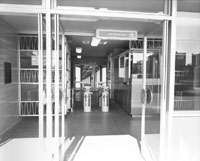
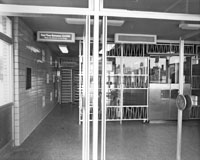
The interiors of the
Racine station houses (Racine top, Loomis above) were mostly identical and are seen in 1948 as originally built. They featured light blue glazed block walls, light beige terrazzo floors, stainless steel ticket agent's booths, and a system of backlit overhead signs and movable partitions that could be changed for different staffing needs.
Top: The Racine entrance is shown configured for when a ticket agent is present, with the partitions arranged to channel passengers through the turnstiles or the agent's booth lane. For a larger view, click here.
Above: The Loomis entrance is shown configured for when no agent is on duty and only exiting is allowed through the Loomis house. The partitions are configured to block off access to the agent's booth and turnstiles, allowing passage only through the exit-only rotogate along the side of the interior. For a larger view,
click here. (CTA photos) |
Each street-level station entrance was identified by a large, electrically illuminated sign (since removed from all Congress stations). This type of advertising was far more proactive than anything posted in front of most stations previously, although this may have been a requirement, in part, necessitated by the removal of the station entrance from the surrounding neighborhood and its isolation in the middle of the expressway, coupled with the invisibility of the tracks and trains themselves, hidden in the open expressway cut.
Inside each station building, the floors were terrazzo, light beige in color with reddish brown and dark green marble chips and aluminum dividing strips. Ceilings were painted a light tint of blue-green. The station buildings were equipped with an agent's booth, an agent's toilet room only accessible from inside the agent's booth, a porter's closet, electrical storage rooms, turnstiles, transfer issuing machines, and a single wall-mounted pay telephone.
The ticket agent's booths were framed of structural aluminum with patterned stainless steel sheet on exterior faces and plate glass ticket agent windows. The booths were equipped with agent-controlled turnstiles. The entrance turnstiles which were not adjacent to the booths were self-service, operated with coins or a CTA fare token, and coupled with a transfer issuing machine which issued transfers automatically if sufficient fare was deposited.
Another feature of each station interior was a system of movable partitions made of polished glass and aluminum grills and safety glass, which could be easily moved by the station agent and used to reconfigure the entrance to either require passengers to pass through the turnstiles, or close off the turnstiles and allow access through the building via a passage along the side. This provided flexibility for staffing the stations, allowing them to be configured for being staffed by an agent (whereby the panels channeled all passengers to either the ticket agent's booth or a self-service turnstile) or unstaffed (allowing access directly to the platform where a train conductor would collect fares, or in certain "secondary" entrances channeling passengers to an exit-only rotogate, making the facility exit-only with no entry -- Loomis was one such station house allowing for the exit-only configuration). Changeable-message signs outside the front doors of the secondary entrances like Loomis, hung under the front eave of the roof and operated by switches in the agent's booth, informed the passengers of the configuration of the station house (entry, entry-pay on train, or exit-only) at a given time.
Recalling that the platform is set between two streets a quarter mile apart, there is a rather long distance that needs to be traversed between the station houses and the platforms in between. Thus, connection between the station houses and platform was achieved using long ramps from the back of the station houses to the ends of the platform. The ramps were originally enclosed with light green corrugated structural glass panels (alternated very 50 feet with vertical panels with fixed aluminum louvers for ventilation) extending from a curb at the floor to continuous horizontal louvers at the ceiling to protect the passengers from the weather, and were brightly illuminated.
All of the original Congress Line platforms were 600 feet long, able to accommodate up to ten-car trains, and between 12 to 15 feet wide. The platforms have a concrete floor, with the edges originally trimmed with a strip of abrasive tiles. The platforms are covered by a continuous canopy supported on columns and beams, with aluminum roofing sheets and gutters. The welded H-beam columns are split at the web and bent to form a "Y" with curved arms extending outward toward the platform edges. The canopies extend beyond the platform edge and over the roofs of cars.
The contract to build the 15 station buildings on the initial section of the Congress Line was awarded in February 1957 to a joint venture of two companies -- the M.J. McDermott Company of Chicago and the Contracting and Materials Company of Evanston -- who submitted a low bid of $3,678,970. The stations were built quickly, well underway by July and nearing completion by November 1957. This initial section of the Congress Line, as far west as Lotus Avenue (5246 West), opened on June 22, 1958.
Developments in the CTA Era
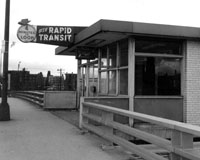
The Loomis station house at Racine station is seen on November 14, 1972, looking a bit worn but its original design and fixtures still very much intact. A few months later, it would be discontinued as a staffed entrance. For a larger view,
click here. (CTA photo) |
In February 1973 (a year in which several waves of CTA service reductions occurred),
the Loomis entrance to Racine closed as a cost-cutting
measure, but was retained as an exit. In 1977, the Loomis
entrance was reopened for entrance from 1415 to 1640 hours
on school days only, to service a nearby school. It was
short-lived, as the entrance closed once again in 1981. In
1988, the back-and-forth continued, with Loomis reopening
for entrance between 1415 and 1800 hours Monday-Friday only,
presumably again to service the nearby school. The Loomis
entrance has since returned to full-time status and is
regularly used; it is particularly busy in the afternoon when
school lets out.
At a press conference on Monday, June 5, 2000,
CTA President Frank
Kruesi announced that beginning Saturday, June 10 or Sunday, June 11 (depending on the location), six downtown area "L" and subway stations
and seven station entrances that were closed late
at night or on weekends would be open at all hours that
trains were in service. One of the seven secondary station
entrances identified that was a Part-Time Entrance -- closed nights and
weekends -- was the Loomis entrance to Racine station.
Starting at 0600 hours Saturday, June 10, 2000, Loomis entrance
returned to 24-hour operation. Reopening these stations and
entrances full-time was one of the components of a $539,000
service improvement package that was passed by the Chicago
Transit Board in May 2000.
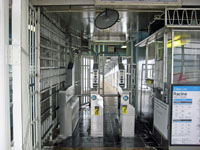
The interior of the Loomis station house is seen on February 2, 2010. The original agent's booth remains, as does some of the original grilles and partitions, such as over the booth and to the left of the modern turnstiles. However, new, white-painted metal fencing has been added to extend the original partition back behind the turnstiles as well as all the way to the front doors, creating a more caged appearance. For a larger view, click here. (Photo by Graham Garfield) |
By 2001 (and likely some years earlier), some of the original movable partition gates had been removed, replaced with a system of fixed fencing and swing gates that partitioned off the interior. The original partition that separated the turnstiles from the lane to/from the exit rotogate remained (though its glass panels had been swapped for metal mesh panels), but fixed floor-to-ceiling metal fencing was added extending this partition all the way to the front doors, between the two sets of the doors. This meant that when both sets of front doors were unlocked, passengers could access both the exit rotogate and the unpaid area with the Customer Assistant booth, fare vending machines and turnstiles; but, if the south set of door was closed, the unpaid area was totally inaccessible but exiting was still possible through the rotogate, passageway along the north edge of the station house interior, and north set of front doors. Swinging gates that could be closed and locked were also installed immediately inside the south set of front doors and just beyond the turnstiles, so that if the station was unstaffed passengers could still exit but would be diverted to the rotogate exit path; these full-height gates also ensured a high level of security for the unpaid area and its equipment when no staff was assigned, even if someone broke in the locked front doors. Unfortunately, it also gave the Loomis station house interior a very confined, uninviting look and feel.
The CTA's 2002-2006 Capital Improvement Plan included a $3,070,161
project to design replacement facilities for five rapid
transit stations, including Racine on the Congress branch of
the Blue Line. These stations would be ADA-accessible when
reconstruction was complete. Initial funding provided
for station design only; post-FY 2007 funding would be
required to reconstruct the station. This project never proceeded, however.
At its June 4 , 2003 monthly meeting, the Chicago Transit
Board approved a $569,973 contract for Chicago-based Camp
Dresser & McKee, Inc. to design and prepare construction
bid documents for the
CTA's "Front Door
Program" that would have added amenities to station entrances
throughout the rail system. The "Front Door Program"
includes making improvements to station entrances, enhancing
connections to bus routes and improving bicycle access and
storage facilities. Upgrades were to include station
identification signage, new fencing, improved lighting
systems, and other amenities. Seven stations were scheduled
for entrance upgrades as part of the initiative, including
Racine. Funding for the contract was provided by the FTA and
the Regional Transportation Authority (RTA). The improvements were designed but never performed, however, with the project funds diverted to other needs. Interestingly, the CTA Identifier signage designed as part of the Front Door Program and originally planned for Racine as part of the initial rollout in 2003 would eventually be installed at the Racine entrance when the station was reconstructed in 2024.
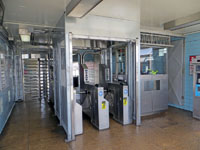
The Loomis entrance interior is seen on March 31, 2016, following the reconfiguration work in 2014. All of the original partitions have been removed (except for a small grille panel above the booth), replaced by a new enclosure with rolling gates that can be lowered to perform a similar function but providing a much more open interior space. For a larger view,
click here. (Photo by Graham Garfield) |
In summer 2013, a modest in-house project was initiated to address issues with the Loomis station house at the Racine station, in particular deterioration that had developed in the roof resulting in leaks and improvements to the interior fare control arrangement to provide access to fare vending during periods when the entrance was unstaffed as well as a more open, more inviting appearance. The design for the interior arrangement continued to develop and be refined over the following year, until it was finalized in summer 2014. The new interior arrangement was similar in principle to the old one, where passengers could be channeled different ways depending on how the station was staffed, but did so in a way that provided more flexibility and less full-height fencing. The exit-only rotogate inside the Loomis station house was replaced in the same location with a High-Barrier Gate (HBG) turnstile, which permitted both entry and exiting but whose tall profile and rotating enclosure minimized the opportunity for fare evasion. This allowed Loomis to still be available for entry even if the station was unstaffed. The existing partitions (including the original 1958 ones) and fencing were removed, and a full-height enclosure was installed just around the turnstiles themselves, with rolling gates in front and behind them which could be lowered when the station was unstaffed. This provided the same benefit of closing off the regular turnstiles, which can be more easily jumped over, when the entrance is unstaffed, but leaving the rest of the unpaid area open visually and more accessible, including maintaining access to the fare vending machines even during periods of unstaffed HBG-only entry. The Loomis entrance was closed over the weekend of September 5-8, 2014, from 10pm Friday to 4am Monday, to allow the bulk of the interior rearrangement and installation work to occur.
Work on the roof continued into 2015. This work included removal of the steel beam that projected over the front of the station house and originally supported the backlit and neon entrance identity sign the station opened with.
Station Renovation, Preservation and Accessibility
In 2022, CTA announced plans to renovate the Racine Blue Line station in pursuit of its All Stations Accessibility Program (ASAP), a 20-year blueprint CTA released in 2018 for making all of its rail stations fully accessible to people with mobility disabilities by 2038. The rehabilitation of Racine station is also part of the first phase of the rehabilitation of the Forest Park branch of the Blue Line.
Funding for the project was sourced through Governor J.B. Pritzker's Rebuild Illinois capital program.1
Station Design
The renovated Racine station is designed by Ross Barney Architects.2
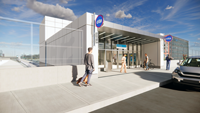
A rendering of the new station house planned for the Racine Avenue entrance show's the new facility's sleek, modern design. For a larger view,
click here. (Image by Ross Barney Architects, courtesy of CTA) |
The Racine renovation project includes fully reconstructing the main station house at Racine Avenue. The new entrance at the Racine end of the station includes a new elevator as well as stairs to connect to the train platform, replacing the old (non-ADA compliant) ramp.3 The boarding platform was also extended eastward toward Racine Avenue to connect to the new elevator and stairs,4 since they descend downward closer to the station house than the sloped ramp they replaced.
The new Racine Avenue station house is a rectilinear structure clad in a polished metal panel system. The glass and metal entry storefront is recessed back from the sidewalk, with the surrounding building envelope and projecting roof creating a covered entrance outside the front doors. An oversize watermark of the CTA logo is integrated into the exterior metal paneling on the station house's north and south elevations. Building-mounted backlit CTA Identifiers frame the entrance on both front corners of the building, which provide ideal visibility from either side of the expressway since the bridge is arched which would impede sightlines to anything beyond the apex of the overpass.
The interior walls are glazed and ceiling consist of suspended metal panels with recessed lighting. A glass skylight runs down the middle of the building, running the length of the interior and continuing unbroken over the stairway down to the platform.
The Loomis Street entrance will also be renovated, including a new ADA-accessible ramp from the station house to the platform.5 The Loomis entrance, however, will receive special treatment as a historically-significant structure, following a determination by the Illinois State Historic Preservation Office (SHPO) on November 8, 2021 that the 1958-vintage Congress Line station houses in general are eligible to be listed on the National Register of Historic Places (NRHP) on two bases: First, that the station houses themselves are eligible under NRHP Criterion A (buildings that are associated with events that have made a significant contribution to the broad patterns of our history) and under Criterion C (buildings that embody the distinctive characteristics of a type, period, or method of construction) as a work of engineering and design. In addition, SHPO determined that the West Side Subway (an early name given to the Forest Park branch when it was built) as a whole is eligible to be listed on the NRHP as a historic district under Criteria A and C at the local level of significance, with the station houses as contributing structures to that District. Based on these findings, the SHPO required the CTA to "mitigate the adverse effects of [the renovation project] to the historic resources" and utilize one of the line's station houses for historic interpretation -- the Loomis entrance to the Racine station was chosen for that purpose.6
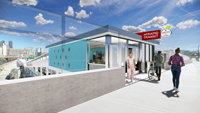
A rendering of the new station house planned for the Loomis Street entrance show's the planned recreation of the original 1950s design, complete with replica station entrance overhead sign. For a larger view,
click here. (Image by Ross Barney Architects, courtesy of CTA) |
The CTA and SHPO signed a Memorandum of Agreement (MOA) on September 22, 2022 that laid out how CTA was required to treat the Loomis station house in the renovation project. The CTA was not required to preserve the original building itself but to construct a replica of the Loomis entrance building in the same location and footprint as the original. The new building could be a new design "inspired by" the historic Loomis entrance, with modification as needed for current codes, current CTA standards, modern maintenance requirements, greater energy efficiency, and structural requirements. Substitute materials were permitted, "provided they substantially match historic materials in regard to size, color, texture, and general appearance." Some specific elements of the original design were specified in the MOA to be retained or replicated, which included the "exterior envelope construction including brick patterning to match original coursing with custom color glaze, 8" x 8" glass block windows, similar aluminum storefront framing system, and flat roof with aluminum fascia", "interior custom color structure glazed facing tile and custom color terrazzo flooring", the long-removed original exterior entrance sign with "Use Rapid Transit" in white lit lettering on a red background (the MOA allows the sign materials to be modernized to current standards), and the also-long-removed custom circular CTA logo door handles (modernized for durability and accessibility, if necessary). The CTA was also required to develop an interpretative element (such as an information panel) that discusses the replication of the Loomis station house, to be physically displayed in the Loomis entrance.7
Once renovated, the Racine station will have clearly defined accessible pathways to and from train platforms, bus stops, and other major modal transfer points. All features along the pathway, such as fare arrays, shelters, benches, and passenger information, will be redesigned to remove barriers and allow for universal accessibility.8
Station Artwork
On December 11, 2024, the CTA announced the hiring of Chicago artist Judy Ledgerwood to create unique artwork for the Racine Blue Line station.
Riders entering the new Racine Avenue station house are greeted by Flowers for the Blue Line Racine Station, a colorful floor-to-ceiling installation of more than 700 hand-crafted ceramic tiles in the main entrance of the station. Ledgerwood worked with Nymphenburg Arts & Design in Munich, Germany to fabricate the artwork. Each glazed tile presents a low-relief surface articulating a single lobe of the quatrefoil. Arranged in a quadrant, the tiles unfold into a stylized four-petaled bloom, evoking symbolic with cardinal orientation, spatial dimensions, and prehistoric fertility figures. As it was created specifically for the Racine station, the motif anchors the site's east-west axis with a visual language of movement and place.9
Ms. Ledgerwood is an internationally recognized painter known for her canvases, monumental wall paintings and ceramics in which she marries abstract painting with the decorative arts. She is best known for her signature motif of the quatrefoil, a four-petal flower shape organized within triangles and chevrons and painted in bold color combinations. Ms. Ledgerwood is a Professor Emeritus at Northwestern University, and her work is included in several prominent public collections including several renowned museums and the Paris RATP transit art collection. The CTA provided $304,500 for the art project, which includes costs for design, engineering, fabrication, delivery, insurance and the artist's fee.10
Station Construction
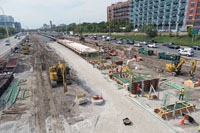
Construction at the Racine Avenue end of the station during the 2.5-month closure of this section of track, looking west on September 20, 2023, shows the part of the new platform extension built, while foundation work is underway for the rest of the extended platform and new station house. For a larger view,
click here. (Photo by Graham Garfield) |
On February 9, 2023, the Chicago Transit Board awarded FH Paschen, S.N. Nielsen & Associates, LLC a contract not to exceed $75.4 million through a competitive bid.11
On Sunday, July 23, 2023, the CTA initiated Phase I of its Forest Park Branch Rebuild program, a multi-year, multi-phased investment to reconstruct the entire Forest Park Branch of the Blue Line. The primary scope of Phase I was to completely rebuild 15,000 feet, or almost three miles, of track between the LaSalle and IMD stations. To accomplish this major track work in just 2-1/2 months, sections of the Forest Park branch were closed completely, continuously, with a bus shuttle replacing train service in the affected area: July 23-late August, train service was suspended and crews rebuilt the track between the UIC-Halsted and LaSalle stations (referred to as "Part A"); Late August-October , train service was suspended and crews rebuilt the track between the IMD and UIC-Halsted station ("Part B"). Through service on the Blue Line resumed early Sunday morning, October 8, 2023.
Racine station was closed for the duration of the 2-1/2 month closure, and this opportunity was taken to begin the reconstruction of Racine station. Soon after the closure started, the Racine Avenue station house and its supports were demolished and the ramp that connected it to the platform was removed. Once removed, foundations were excavated and poured for the new Racine station house and the platform extension to connect it to the existing platform. During the remainder of the track closure, the structure of the new platform extension was built.
When the tracks reopened on October 8, the Racine station reopened but with access only from the Loomis Street entrance; the Racine entrance remained closed while its reconstruction continued.
Blue Line service was suspended between UIC-Halsted and IMD over the weekend of April 26-29, from 10pm Friday to 4am Monday, to accommodate construction work at the Racine Blue Line station and Morgan substation. Free bus shuttles replaced Blue Line service.
The Racine station entrance reopened following reconstruction at 8am, Friday, October 10, 2025. Upon reopening, the entrance's new elevator was in service, making the station ADA-accessible.
At 12:01am, Monday, October 13, 2025, the Loomis entrance closed for reconstruction. The Loomis entrance is expected to reopen in 2027.12
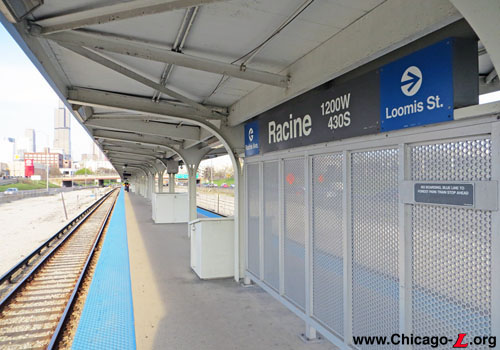
The Racine island platform is seen looking east near the Loomis entrance on May 2, 2015. Except
for the sandboxes, tactile edge panels, newer windbreaks and Green Line standard
signage, it has changed little since the day it opened. Note
the extra space on either side of the tracks: the
Congress Line was built with extra room for the installation
of two express tracks. For a larger
view, click here. (Photo by Graham Garfield)
|

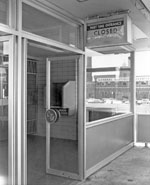 |
racine_19580000b_loomis.jpg (152k)
The secondary entrances to Congress stations, such as the Loomis entrance to Racine, had changeable-message signs outside the front doors, hung under the front eave of the roof, which informed the passengers of the configuration of the station house at a given time: Open, Open-Pay on Train, or Closed (exit only). The readings were printed on a roller curtain whose position was changed by switches in the ticket agent's booth. Here, the sign outside the Loomis entrance is set to inform would-be passengers that the entrance is closed and to enter at the other end of the station at Racine Avenue, on the next bridge over the expressway. (CTA photo) |
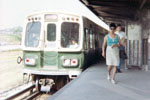
|
cta2145.jpg (177k)
A Congress-Milwaukee "A" train of 2000-series cars, lead by car 2145, stops at Racine on the Congress Line on June 10, 1968. Only 40 of the 180 2000-series cars were assigned to the West-Northwest Route when they arrived in 1964, and it proved short-lived -- in autumn 1969, these 40 joined the other 140 on the Lake-Dan Ryan line. Note the hoop sticking off the side of the train -- this was an "Identra Coil", an electronic device which, when passed in front of a trackside receiver,
automatically set the switch at Loomis Junction for the proper route for the train. (Photo from the Scott Greig Collection) |

|
cta2166.jpg (118k)
A two-car westbound Douglas-Milwaukee "B" train, led by car
2166 in its Mint Green and Alpine White paint scheme, stops
at Racine on July 20, 1968. (Photo by Doug
Grotjahn, Collection of Joe Testagrose) |
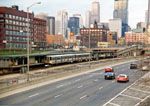 |
racine_19980328.jpg (261k)
The Racine platform, as seen from the Loomis Street overpass. The ramp on the left goes to Loomis; the one on the right goes up to Racine Avenue. (Photo by Graham
Garfield) |
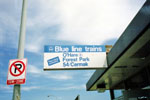 |
racine_19990000_loomis.jpg (129k)
A standard station entrance sign (sometimes called a "promo sign") of the type used in the late 1990s is seen outside the Loomis station house at the Racine station in 1999. This sign is a variant with a badge on the side informing passengers it is a part-time entrance. (Photo from the Graham Garfield Collection) |
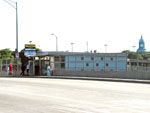 |
racine_20010627_racine.jpg (108k)
The station house at Racine, looking southwest in June 27, 2001. (Photo by Graham
Garfield) |
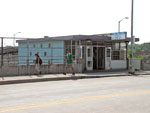
|
racine_20010627_loomis.jpg (148k)
The station house at Loomis, looking southeast in June 27, 2001. This station house and Racine Avenue's above started at as nearly identical -- and still appeared so on the exterior -- although Loomis's retained more of its original interior arrangement and equipment. (Photo by Graham
Garfield) |
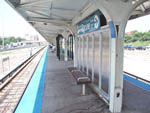 |
racine_20010627.jpg (198k)
The Racine island platform,
looking west near the Racine entrance in June 27, 2001. Except
for the benches, tactile edge panels, newer windbreaks and
1970s KDR-style signage, it had changed little since the day it opened. (Photo by Graham Garfield) |
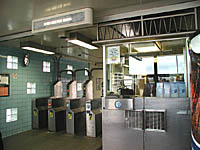 |
racine_20031026a_racine.jpg (158k)
The interior of the Racine entrance, seen here on October 26, 2003, still had many of its original features, including the agent's booth, overhead sign and backlit graphic, and the tile and glass block walls. The grillework above the agent's booth was a remnant of a complex system of movable partitions the station originally had, seen in this 1958 photo above. (Photo
by Tony Coppoletta) |
|
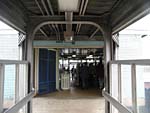
|
racine_20031026b_racine.jpg
(152k)
The interior of the Racine station house is visible
at the top of the long ramp from the platform, seen looking
east on October 26, 2003. (Photo
by Tony Coppoletta)
|
|
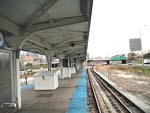
|
racine_20031026a.jpg
(139k)
Like most stations, time brought several additions to
the Racine platform, seen looking east on October 26, 2003.
The sandbox and supervisor's booth are both later additions,
and the stainless steel windbreak on the left replaces an
original model of a different design. The University of
Illinois at Chicago's University Hall tower is in the
distance on the right, while the Racine station itself
provides convenient access to UIC's Pavilion and Student
Services Building. (Photo by Tony
Coppoletta)
|
|
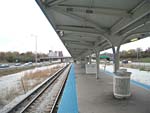
|
racine_20031026b.jpg
(136k)
The Racine island platform, seen looking west toward
to Loomis entrance on October 26, 2003, is typical in design
for the Congress stations, with purely practical and
functional forms and methods of construction. The wide
spaces on either side of the tracks are for express tracks,
yet to be installed. (Photo by Tony
Coppoletta)
|
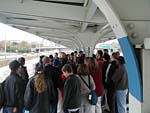
|
tour03@Racine01.jpg (147k)
The tour group is tightly assembled on the island platform
at Racine station during
the 5th Annual Historic "L"
Station Tour on October 26, 2003, while tour guide
Graham Garfield described the history and design of the
station over the roar of the adjacent expressway
traffic. (Photo by Tony
Coppoletta) |
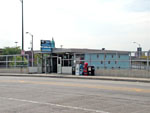 |
racine_20041001_racine.jpg (138k)
The Racine Avenue station house is seen looking southwest on October 1, 2004. Apart from the replacement of the front doors, entrance sign and lights under the front eave, the exterior of the station house is still very much as originally built. (Photo by Graham Garfield) |
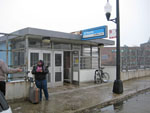 |
racine_20100202a_loomis.jpg (186k)
The Racine Avenue station house is seen looking southeast on February 2, 2010. Like the Racine entrance above, the exterior of the station house is still very much as originally built aside from the front doors, entrance sign and lights under the front eave. Inside there has also been a lot of addition full-height fencing and security bars behind the front windows installed, visible from outside, to secure the building when it is unstaffed but allowed exiting. (Photo by Graham Garfield) |
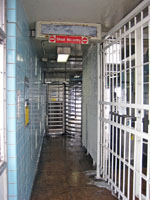 |
racine_20100202c_loomis.jpg (236k)
The passage along the north side of the interior of the Loomis station house, which led from the exit-only rotogate to the front doors, is seen looking east on February 2, 2010. The backlit sign box on the ceiling is original to the 1958 station but its graphic insert no longer legible -- as seen in this photo, it read, "Part Time Entrance CLOSED / Please use entrance at next bridge" -- so a static "Stop! No entry" sign was appended below it. Although this corridor was always part of the station for when it was configured for unstaffed exit-only, originally the movable partitions allowed access to the rest of the unpaid area interior. Later, more full-height fencing was installed, seen in the right foreground, which extended the passageway all the way to the front doors. (Photo by Graham Garfield) |
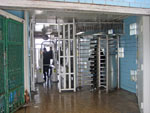 |
racine_20100202d_loomis.jpg (235k)
The interior of the Loomis station house is seen from the top of the ramp from the platform on February 2, 2010. The green gates on the left and the grille panel over the rotogate on the right are original to the station, once part of a system of movable gates and partitions to configure access through the station according to staffing levels. The white-painted metal fence and gate (whose door is open to allow access through the turnstiles) was added later, replacing part of the original partition system. (Photo by Graham Garfield) |
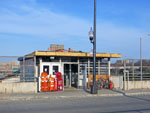 |
racine_20150502a_loomis.jpg (176k)
Repairs to the roof of the Loomis station house at Racine are underway in this view looking east on May 2, 2015. (Photo by Graham Garfield) |
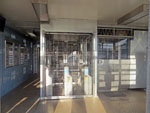 |
racine_20150502b_loomis.jpg (187k)
The Loomis entrance interior is seen on May 2, 2015, following the reconfiguration work in 2014. The new enclosure with rolling gates is seen here in the "unstaffed entrance" configuration, with the gates lowered to block off access to the regular turnstiles (which are more likely to be hopped over by fare evaders if no staff are present at the entrance). Instead, passengers are channeled to the left, down a side passage that leads to a High-Barrier Gate (HBG) turnstile that allows both entry and exit but is full-height, making it impossible to jump over. (Photo by Graham Garfield) |
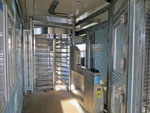 |
racine_20150502c_loomis.jpg (233k)
The High-Barrier Gate (HBG) turnstile at the end of the side passage inside the Racine station Loomis station house is seen on May 2, 2015. The turnstile combs rotate both ways -- freely in the exiting direction, and unlocks and rotates in the entering direction upon valid fare payment on the turnstile in front. The tall height of the HBG, along with the fencing above and along side, makes it very difficult to circumvent, providing a reasonably secure fare barrier even when the entrance is unstaffed. (Photo by Graham Garfield) |
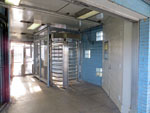 |
racine_20150502d_loomis.jpg (181k)
The interior of the Loomis station house is seen from the top of the ramp from the platform on May 2, 2015. Following the reconfiguration work in 2014, the interior is much more open and less confined looking -- compare to the same view in 2010, above, before the reconfiguration work. The station house is set up for being unstaffed, with the rolling gates lowered to block off access to the regular turnstiles on the left. As a result, passengers are channeled to the High-Barrier Gate (HBG) turnstile on the right which allows both entry and exiting. (Photo by Graham Garfield) |
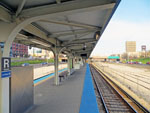 |
racine_20150502a.jpg (220k)
The Racine station platform on the Forest Park branch is seen looking east on May 2, 2015. The structure is still very much as originally built, with the platform and canopy with Y-shaped center columns and up-swept covering unchanged. Modern touches include newer benches and windscreen partitions, the blue tactile panels along the platform edge, the white sandboxes, and the metal cabinet on the left which contains a portable "gap filler" ramp to bridge the gap between the train and the platform for customers boarding and alighting in a wheelchair. Buildings of the University of Illinois at Chicago campus are visible on the right. (Photo by Graham Garfield) |
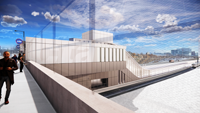 |
racine_20230800_rendering-racine02.png (12.2MB)
A rendering of the new station house planned for the Racine Avenue entrance show's the new facility's sleek, modern design. This view, looking southwest, makes the high fencing that will actually be along the overpass translucent to reveal a watermark of the CTA logo that will be part of the station house's exterior metal paneling. The gently-sloping roofline of the new stairs down to the platform and elevator tower above are also visible. (Image by Ross Barney Architects, courtesy of CTA) |
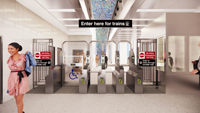 |
racine_20230800_rendering-racine03.png (11.4MB)
The planned design of the new Racine Avenue station house interior is depicted in this rendering. The walls are glazed and ceiling consists of suspended metal panels with recessed lighting. A glass skylight down the middle of the building, running the length of the interior and continuing unbroken over the stairway down to the platform appears to be reserved for an art installation in the glazing. (Image by Ross Barney Architects, courtesy of CTA) |
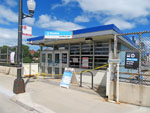 |
racine_20230830_loomis.jpg (217k)
The Loomis station house is seen looking east on August 30, 2023, during the temporary closure of this section of the Forest Park branch for track and trackbed construction. Signage informs customers about the closure, alternate service options, and directs them where to board free shuttle buses that replace train service. Without a CTA Customer Assistant at the entrance or a regular flow of customers, a little graffiti has appeared on the doors, but it was removed before the station reopened in early October. (Photo by Graham Garfield) |
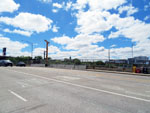 |
racine_20230830a_racine.jpg (194k)
The Racine Avenue overpass is seen looking southwest on August 30, 2023, with the Racine station house demolished. Compare to the same view in 2004 with the station house still present. The tall boom of a drill rig is visible behind the bridge, which is situated on the "L" right-of-way below the bridge, drilling foundations for the new station house. (Photo by Graham Garfield) |
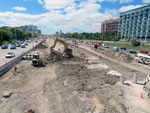 |
racine_20230830b_racine.jpg (291k)
The Forest Park branch right-of-way is seen looking west from the Racine Avenue bridge on August 30, 2023, during the 2-1/2 month Forest Park Branch Rebuild Phase I closure. The tracks have been completely remove to allow the drainage system and other subsurface infrastructure to be repaired and renewed before new tracks are installed. The old Racine station house and ramp have also been demolished, and installation of foundations for the new station house and platform extension are underway. (Photo by Graham Garfield) |
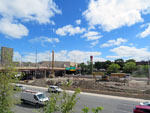 |
racine_20230830c_racine.jpg (228k)
Reconstruction of the Forest Park branch right-of-way and Racine Avenue station entrance are underway in this view looking south from the Van Buren Street frontage road on August 30, 2023. A gap in the overpass's side wall reveals where the Racine Avenue station house was before it was demolished. (Photo by Graham Garfield) |
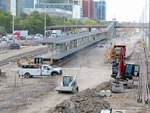 |
racine_20230830a.jpg (276k)
The Racine station platform is seen looking west from the Racine Avenue overpass on August 30, 2023. The station is closed, with the 2-1/2 month Forest Park Branch Rebuild Phase I closure about halfway over. The Loomis Street station house and connecting ramp are in the background, and the Loomis Incline that connects the Forest Park branch to the Cermak branch elevated tracks can be seen in the far background. The Racine Avenue station house and ramp have been demolished, temporarily giving Racine the appearance of one of the single-end Congress stations, like Western or California. (Photo by Graham Garfield) |
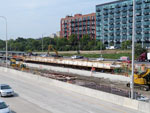 |
racine_20230920a_racine.jpg (257k)
The new platform extension at the east end of the existing Racine platform to meet the planned stairs and elevator up to the new Racine Avenue station house is seen under construction looking northwest on September 20, 2023. The new ballast trackbed for the new Forest Park branch tracks is also in place. (Photo by Graham Garfield) |

- Racine_Blue_next.wav
(119k): "Racine is next. Doors open on the left at
Racine." (Sound courtesy
of Tony Coppoletta)
Notes:
1. "CTA Moves Forward on 'All Stations Accessibility Program' Awarding $75 Million Contract for Racine Blue Line Station Improvements." CTA press release, February 9, 2023.
2. Achong, Ian. "Permits Issued For CTA Blue Line Racine Station Reconstruction." Chicago YIMBY, August 25, 2023."
3. CTA press release, Feb. 9, 2023.
4. "CTA Approves Contract to Begin First Phase of Track Reconstruction Work of the Forest Park Branch of the Blue Line." CTA press release, December 14, 2022.
5. CTA press release, Feb. 9, 2023.
6.
Chicago Transit Authority (CTA) and Illinois State Historic Preservation Office (ISHPO). "Memorandum of Agreement between the Chicago Transit Authority and Illinois State Historic Preservation Office Regarding Demolition and Rehabilitation of Racine (Congress Line) Station at 430 South Racine Avenue and 431 South Loomis Avenue [sic] in Chicago, Illinois (SHPO log #009080221)." Executed Sept 22, 2022. Accessed Jan 27, 2023.
7 Ibid.
8. CTA press release, Feb. 9, 2023.
9.
"Racine Blue Line Main Stationhouse Reopens with Accessibility Improvements and Vivid Public Artwork." CTA press release, October 10, 2025.
10. "CTA Selects Local Artist to Create Vibrant Artwork for the Racine Blue Line Station." CTA press release, December 11, 2024.
11.
CTA press release, Feb. 9, 2023.
12. CTA press release, Oct. 10, 2025.












































